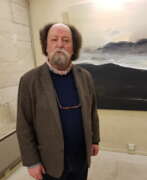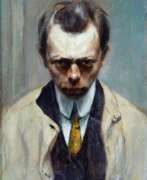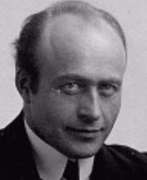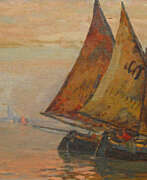Portraitist Rural landscape


Wilhelm Schmurr was a German painter and co-founder of the Sonderbund in Düsseldorf. His style, characterized by clear expression, was influenced by the Pre-Raphaelites, Symbolists, and Realists. He received several awards and medals for his work and was a member of various art associations. Schmurr taught at the Kunstakademie Düsseldorf and inspired by the farmers after the war, he created scenes of simple life and still lifes. He was awarded the Karl-Ernst-Osthaus-Preis and the Bundesverdienstkreuz erster Klasse and became an honorary member of various artist associations.


Berenice Alice Abbott was an American photographer best known for her portraits of between-the-wars 20th century cultural figures, New York City photographs of architecture and urban design of the 1930s, and science interpretation in the 1940s to 1960s.


Friedrich Ahlers-Hestermann was a German painter and art writer from Hamburg. He was a member of the Hamburgische Künstlerclub of 1897, as well as of the Hamburg artist's workshop of 1832 and pupil of the Académie Matisse in Paris. After the First World War, he was a co-founder of the Hamburg Secession.
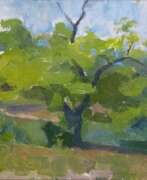



Louise Elisabeth Andrae was a German Post-Impressionist landscape painter and watercolorist. She studied with two landscape painters; Gustav Adolf Thamm in Dresden and Hans von Volkmann in Karlsruhe. She settled in Dresden, but spent long periods on the island of Hiddensee. There, she helped organize a group known as the Hiddensoer Künstlerinnenbund, an association of women artists that included Clara Arnheim, Elisabeth Büchsel, Käthe Loewenthal and Katharina Bamberg. They were regular exhibitors at an art venue known as the Blaue Scheune (Blue Barn), established in 1920 by Henni Lehmann. She also exhibited frequently with a group known as the Kunstkaten in Ahrenshoop.Wikipedia


Gottfried Albert Maria Bachem was a German painter and illustrator of the Düsseldorf School. Bachem, who belonged to the Malkasten artists' association from 1921 to 1932, painted portraits, genre scenes and landscapes, and he also illustrated children's books. From 1900 he took part in numerous art exhibitions, including in Berlin.
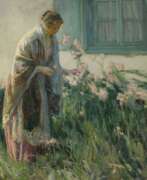

Myron G. Barlow was an American painter and illustrator known for his genre scenes, portraits, and landscapes. He was began his artistic training at the Art Institute of Chicago. Later, he studied at the Académie Julian in Paris, where he was influenced by the Impressionist and Post-Impressionist movements.
Barlow worked as an illustrator for various publications, including Harper's Weekly, Scribner's Magazine, and The Saturday Evening Post. He also taught at the Art Students League in New York City.
Barlow's paintings often depicted everyday life, with a focus on working-class people and their surroundings. His use of color and light gave his paintings a sense of warmth and intimacy.
Barlow was a member of several art organizations, including the National Academy of Design, the Society of American Artists, and the American Watercolor Society. He received numerous awards and honors during his lifetime, including a gold medal at the Panama-Pacific International Exposition in San Francisco in 1915.
Today, his paintings can be found in several museums and institutions, including the National Gallery of Art in Washington, D.C., and the Brooklyn Museum in New York City.


George Barret the Younger was a British painter, master watercolorist and landscape painter.
He was the son of the Irish painter George Barret the Elder (1730-1784) and learned painting from his father. He exhibited at the Royal Academy from 1800 and was one of the first and active members of the Society of Watercolor Painters, which was formed with his own encouragement in 1804. His early works were mainly topographical landscapes in a style similar to his father's watercolors. Later he switched to more romantic compositions with imaginary landscapes.
In 1840, George Barret published The Theory and Practice of Watercolor Painting.


Otmar Blaser is a contemporary German artist. In 1967 he studied at the Werkkunstschule with Prof. Holweck. In 1968 he traveled through Europe, the Middle East, Canada and America. From 1970-1976 he studied at the University of the Arts in Berlin. In 1975 he was a master's student with Professor Bachmann, in 1976 he was an assistant to Professor Kapitsky at the Institute of Visual Communication and Design. In 1977 he was a lecturer at the Volkshochschule Berlin-Neukölln, collaborating freelance with the Theatertreffen Berlin.


Ernest-Stanislas Blanc-Garin was a Belgian portrait and landscape painter. He came to Brussels in 1863 and became a student of Jean-François Portaels. After that he went to Paris and joined the studio of Alexandre Cabanel, became a student of the Ecole des Beaux-Arts. He took part in the 1867 Prix de Rome competition (“The Murder of Laïus by Oedipus”) and received an honorable mention at this competition in 1868. After a stay in Italy, he settled permanently in Brussels in 1871 and opened a private painting academy. In 1891 he became one of the founding members of the Société des Beaux-Arts de Bruxelles.


Francois Boisrond is a contemporary French painter. He studied from 1977 to 1980 at the National School of decorative Arts. In 1981 he became involved in the Free Figuration movement. Inspired by visual products (advertising products, posters, stickers, video games etc.), cartoon characters, and by using acrylic paint, Francois Boisrond’s works are colourful, figurative and enigmatic, and his simplified shapes are often outlined in black. He portrays mainly characters, frequently symbolic in everyday situations, but he also depicts urban, maritime or rural landscapes. Besides this Boisrond creates humanitarian and publicity posters. Since the 1990’s the artist has become interested in an imaginary public and the everyday life that invades each and every one of us.


Erwin Bovin is a German painter and poet. He received his first art education at the School of Applied Arts in Neuchâtel under the direction of William Racine. He took part in the First World War as an interpreter. During this time, he created, among other things, drawings and watercolors depicting the front in the Argonne forest. After the war, he continued to study and worked as an art teacher. In 1932-1942 he lived as a freelance artist. After leaving his position as a teacher, he went to Amsterdam to visit the Rembrandt exhibition there, and then stayed to live in the Netherlands. In addition to landscapes, Bovin painted numerous portraits and family paintings for wealthy Dutch people.


Theodore Penleigh Boyd was a British born Australian artist. Penleigh Boyd was a member of the Boyd artistic dynasty: his parents Arthur Merric Boyd and Emma Minnie Boyd (née à Beckett) were well-known artists of the day, and his brothers included the ceramicist Merric Boyd and the novelist Martin Boyd. Penleigh Boyd is best known as a landscapist with an accomplished handling of evanescent effects of light. A notable influence was artist E. Phillips Fox, who introduced him to plein air techniques when they were neighbours in Paris.


Emma Minnie Boyd, born Emma Minnie Beckett, was an Australian artist. She exhibited publicly between 1874 and 1932 with the Victorian Society of Artists, the International Centenary Exhibition of 1888 (Melbourne), the Royal Academy of Arts (London) and in a joint exhibition with her husband at Como House in Melbourne in 1902.
Emma Minnie Boyd had a talent for watercolour landscapes, although she painted in both watercolour and oil, depicting interiors, figures, portraits, still lifes and floral studies. She is part of the Boyd artistic dynasty that began with Emma and her husband Arthur.


Elisabeth Büchsel, full name Elisabeth Charlotte Helene Emilie Büchsel, was a German artist. She studied painting in Berlin, Dresden, Paris and Munich.
Elisabeth Büchsel painted mainly portraits and landscapes of Rügen and Stralsund. From 1904 she lived and worked on the island of Hiddensee from spring to autumn.
Büchsel was a member of the Association of Visual Artists of Germany.


Lionel Victor Bulmer was an English impressionist painter, a member of the New English Art Club, founded in 1886 as an exhibition society dedicated to promoting the avant-garde technique of French impressionist painting, the influence of which was clearly evident in Bulmer's own work.


Anton Burger was a German painter, draftsman and etcher. He was a prolific and versatile painter, producing works in almost every genre. His paintings sold very well and, in the area around Kronberg, it was considered a sign of good taste to have a "Burger" in one's home. In 1861, he and Jakob Fürchtegott Dielmann (an old friend from his days at the Städelschule) founded the Kronberg Artists' Colony, where he remained until his death. He was highly regarded and came to be known as the "King of Kronberg".


Lilla Cabot Perry, birth name Lydia Cabot Perry, is an American impressionist painter.
Lydia Cabot Perry began painting after her marriage and the birth of her children. Some time spent in Japan and France, where she painted a lot. After meeting Claude Monet, which took place in 1894, the artist sharply changes his style and technique of image. Among other genres, she favoured landscape painting.


Richard Corbould was an English artist. He was a painter, in oil and watercolour, of portraits, landscape, and occasionally history; of porcelain, and miniatures on ivory, and enamels; and was furthermore an important illustrator of books renowned for his Napoleonic sketches of Ships, and a follower of the old masters. From 1777 to 1811 he was a constant contributor to the Royal Academy.


Ray Austin Crooke was an Australian artist known for for serene views of Islander people and ocean landscapes, many of which are based on the art of Paul Gauguin. He won the Archibald Prize in 1969 with a portrait of George Johnston. His painting The Offering (1971) is in the Vatican Museum collection. Many of his works are in Australian galleries. He was made a Member of the Order of Australia in the 1993 Australia Day Honours, "in recognition of service to the arts, particularly as a landscape artist".


Alexander Joseph Daiwaille was a Dutch portrait painter. He specialized in painting portraits, like his father, although he later in life painted landscapes. He traveled and worked all around the Netherlands and Germany. Daiwaille then moved and settled in Brussels where he lived until his death in 1888.


Rodolphe De Saegher is a Belgian artist, lawyer and politician. An eminent representative of the luminist pictorial current, he is one of the founders of the artistic circle "Vie et Lumière". Rodolphe De Saegher's work consists mainly of pastels on paper, generally of modest dimensions. The artist fixes on the motif, in direct observation of nature, his impressions of the Flemish countryside, mainly around the Lys, but also his memories of travels, in France and Norway in particular. An eminent representative of the Luminist current, his work is characterized by a particular grace and a very fine coloring, synthetic and stylized evocations reflecting the atmospheric variations in all seasons and at different times of the day of landscapes familiar to the artist. He will also paint in watercolor and oil in the same spirit. Rodolphe De Saegher was also a gifted portrait painter. He will repeatedly caricature the members of the various councils on which he will sit during his political career as well as his collaborators in the legal community. Several pastels by Rodolphe De Saegher appear in particular in the collections of the Museum of Fine Arts of the city of Ghent.


Arthur Degner was a German painter, graphic artist and sculptor. Degner studied between 1906 and 1908 at the Art Academy in Königsberg under Ludwig Dettmann and Otto Heichert. In 1909 he came to Berlin after a stay in Munich. In 1912 he exhibited in the gallery of Paul Cassirer, at whose suggestion he had traveled to Paris in 1910. In 1919 he became a board member of the Free Secession, of which he had been a member since 1911. In 1920 he was appointed to the Königsberg Academy. In 1925 he returned to Berlin, where he taught at the Academy of Fine Arts (HBK). From 1931 to 1933 he was chairman of the Berlin Secession. After the National Socialists seized power, he was banned from working and exhibiting. Nevertheless, the Villa Romana Prize of the German Association of Artists enabled him to study in Florence in 1936 and in 1937 he became a member of the Association of Berlin Artists.
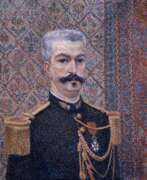

Albert Dubois-Pillet was a French Neo-Impressionist painter and army officer. He played an important role in founding the Société des Artistes Indépendants and was one of the first artists to embrace Pointillism.
Albert Dubois-Pieu's paintings often depicted landscapes, seascapes and city scenes, conveying the effects of light and atmosphere with meticulous attention to detail. His use of vivid and contrasting pointillistic colours created a sense of depth, brightness and optical blending when viewed from a distance.
Dubois-Pieu was influenced by the theories of colour and light of Georges Seurat and Paul Signac, two prominent figures in the Neo-Impressionist movement. He participated in several exhibitions with these artists and other members of the movement, contributing to the dissemination and appreciation of Neo-Impressionism.


Pierre Louis Dubourcq was a Dutch landscape painter, lithographer and etcher. He was a student of Jan van Ravenswaay in Hilversum in 1834 and of Andreas Schelfhout in The Hague in 1835. He mainly painted mountain and forest landscapes and he etched, drew, created watercolors and lithographs. From 1834 to 1858 he took part in the exhibitions in Amsterdam and The Hague. Prince Alexander of Orange-Nassau commissioned him to do some watercolors of the falconry hunts at Het Loo Castle. He was a member of Arti et Amicitiae, the Koninklijke Academie van Beeldende Kunsten and the Natura Artis Magistra Society.
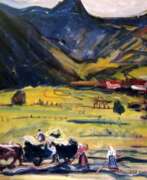

Alphonse Epple was a German landscape, portrait and ecclesiastical painter. In 1919 he studied at the Stuttgart School of Applied Arts under Bernhard Pancock. Presumably, he learned there the technique of fresco painting, the skill in which brought him commissions in later years. His passion was the depiction of religious subjects. In addition to paintings on religious motifs, he painted portraits of friends and acquaintances, landscapes depicting the idyll of his native nature or reflecting an interest in the rural and folk way of life. Apple uses a free, fast brush to capture the ever-changing lighting situation. His oil paintings are characterized by impasto application of paint, and the influence of the Impressionists is especially noticeable in the depictions of landscapes. Completely abandoning contours, Epple formed his compositions from wide dotted lines located side by side.


Max Feldbauer was a German painter, associated with the Munich Secession. He is primarily known for rural, Bavarian scenes. From 1901 to 1915, he taught at the Academy of the Münchner Künstlerinnenverein (women artists' association). In 1908, he joined the Munich Secession. He also ran his own painting school, in Mitterndorf, near the Dachau art colony, from 1912 to 1922. He left the Secession in 1913; becoming one of the founders of the New Secession, and served as a board member. In addition to all of these activities, he provided illustrations for Die Jugend (Youth), a weekly arts magazine.


Georg Fischhof was an Austrian portrait, figure and landscape painter.
Fischhof initially studied architecture, but later devoted himself to painting and studied at the Vienna School of Applied Arts and in Munich. After his return to Vienna he shifted his work to the painted imitation of tapestries. Frequent subjects are Dutch coastal and harbour views, Italian landscapes by the water and rural scenes with a stream or path. In almost every work there are sketched persons / children with only suggested facial features, often a column of smoke from a chimney and in seascapes frequently seagulls in flight, in Italian views umbrella acacias and cypresses.


Poppe Folkerts was a German marine painter, draughtsman and graphic artist. He studied at the Berlin Academy of Fine Arts under Karl Salzmann. In 1907 and 1908 he studied figure and portrait painting in Düsseldorf with Eduard von Gebhardt, before going to Paris in 1909, where he was accepted at the Académie Julian.
Poppe Volkerts is considered one of the most outstanding artists of the Frisian coast. As an enthusiastic sailor, he was able to capture the peculiarities of this landscape, the struggle of people with the forces of nature and the fascination of the sea with its constantly changing weather conditions and moods, with a unique liveliness and intensity. His pastose application of paint, special lighting and pure colours create the spatial depth and radiance inherent in the paintings.
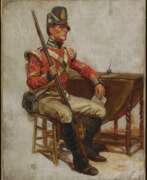

Emile Edwin Ganz is a Swiss-Belgian painter, specializing in the representation of horses and military scenes. In his early days, Ganz mainly drew military scenes, a genre that only a few 19th-century artists mastered. His masterpiece in the genre is The Attack of Scherpenheuvel, a report on the maneuvers of the grenadiers in 1894. In 1901 he entered the service of Princess Clémentine as a painter; he held this position until 1903. In 1903, he also brushed some of King Leopold II's horses. From that moment, he was no longer interested only in the horse itself, but in the regional draft horse, as well as in the people and the rural world: newspaper sellers, old horses in a depot, the harvest in the fields , beet harvest, landscape. Many of his designs for military uniforms were printed in color lithograph.
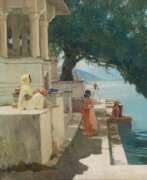



Frauke Gloyer is a contemporary German artist. She studied freehand painting at the University of Fine Arts in Braunschweig. She has been working as a freelance artist since 1988.
Frauke Gloyer's work includes expressionist landscapes, still lifes, portraits and animal studies.


Spencer Frederick Gore was a British painter of landscapes, music-hall scenes and interiors, usually with single figures. He was the first president of the Camden Town Group, and was influenced by the Post-Impressionists.


Willem Grimm was a German painter and graphic artist.
Already during his studies he made a name for himself, especially with his experimental graphics. After several guest exhibitions at the Hamburg Secession, he became an official member in 1929/30. In the early 1930s, at the age of 27, he was already one of Hamburg's most important artists.
In addition to classical genres such as portraits, landscapes and still lifes, Grimm worked from 1931 on the Rummelpott-Szenen motif, which in time became characteristic of his work.
The National Socialist repressions affected Willem Grimm less than many of his fellow artists. Still, in 1937 seven of Grimm's works were confiscated from the Kunsthalle Hamburg, the Hamburg Arts and Crafts Museum and the Nissenhaus Husum Museum as part of the "Degenerate Art" campaign and subsequently destroyed.




Lindsay Bernard Hall was an English-born Australian artist, teacher and art gallery director. He studied painting at the South Kensington School of Art, Antwerp and Munich, and worked for several years in London. He exhibited at the Royal Academy and was one of the original members of the New English Art Club. In 1891 he was appointed director of the National Gallery of Victoria and master of the School of Arts in Melbourne. Hall's paintings were usually interiors, nudes, or paintings of still life.
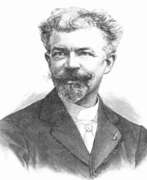

Georges Jean Marie Haquette was a prominent French painter, particularly known for his portrayals of fishermen and maritime scenes. Born in Paris, Haquette trained under notable 19th-century artists Aime Millet and Alexandre Cabanel, drawing influence from French Realist painters like Courbet. His unique focus was on the lives and labors of sea harvesters, differentiating his work from contemporaries who focused more on land-based peasants.
Haquette debuted at the Paris Salon in 1875 and continued to exhibit there, earning various recognitions including an honorable mention in 1878 and medals in 1880 and 1901. His notable works include "Un homme à la mer!" (1886), "La femme du matelot" (1887), and "La levée des filets" (1888). His painting "Net Fishers" was featured in "Famous Paintings of the World" (1894), emphasizing the picturesque and labor-intensive life of coastal peasants.
Many of Haquette's works are housed in prestigious museums, such as those in Brest, Dieppe, Mulhouse, Pontoise, and Rouen. Some of his notable paintings include "Le Manchon de Francine" in the Musée de Brou, "Pêcheurs" in the Musée du Vieux Château, and "Pêcheuse" in the Hôtel de Ville de Rouen.
For collectors, auctioneers, and art and antiques experts interested in Haquette’s work, his paintings represent an insightful view into 19th-century French maritime life and culture. His unique focus on sea harvesters adds a distinctive dimension to French Realist painting.
To stay updated on new product sales and auction events related to Georges Jean Marie Haquette, consider signing up for relevant updates. This subscription will keep you informed about important developments and opportunities in the world of Haquette’s art.




Alfred Hazledine was a Belgian painter and graphic artist. Hazledine was a student of Ernest Blanc-Garin in Brussels and of Adrien-Joseph Heymans. He lived and worked for a long time in Wechelderzande, where there was a true artists' colony. He mainly painted landscapes in Impressionist style. Hazledine was a member of the Vie et Lumière group that brought together Impressionists and Luminists for exhibitions, and was also a member of L'Estampe and of the National Confederation of Painters and Sculptors of Belgium.


Walter Helbig is a German and Swiss painter, graphic designer and woodcarver. He works in Dresden on church paintings. Helbig participated in the founding and first exhibition of the "Neue Secession" in Berlin in 1910. Helbig took part in the first Modern Bund exhibition in 1911 in Lucerne and in the second, larger one, at the Kunsthaus in Zurich. In 1914, some painters from the vanished “Modern Bund”, including Helbig, took part in the first Dada exhibition at the Galerie Coray in Zurich. Helbig is also represented in the third Dada exhibition and contributes to the magazine Der Zeltweg 8 but does not participate in the activities of the Dadaists. In 1919, he was one of the signatories of the “manifesto of radical artists” 9 in Zurich, and joined the “November group” in Berlin. Helbig lived in Zurich from 1916 to 1924 and in 1916 became a member of the GSMBA (Society of Swiss Painters, Sculptors and Architects), in which he regularly participated. Since the First World War, his artistic work has turned to religious and mythical subjects. In 1924 Helbig, like many other artists, moved to Ascona due to the low cost of living and founded the movement Der Große Bär. During this time, Helbig painted landscapes, still lifes and portraits. Walter Helbig had his first major solo exhibition in Zurich in 1948 and became a member of the Association of German Artists in 1952. After the Second World War, he also followed the artistic currents of the time, abstract expressionism and experimented with informal art in the 1960s.


Ernest Martin Hennings (Jr.) was an American artist and member of the Taos Society of Artists. In 1901 that Hennings began taking classes at the School of the Art Institute of Chicago, which was largely based on the great European art schools and made particularly emphasis on the importance of drawing. Hennings took up work as a commercial artist, mostly painting murals and portraits around Chicago. Hennings' primary interest was in portrait painting, with his primary subject being the Native Americans living in and around Taos Pueblo. In 1922 he was awarded the Clyde M. Carr Prize from the Art Institute of Chicago as well as the Institute's Fine Arts Building Prize. By the 1920s, the now established painter was building his reputation on the national scene, with exhibitions and awards including. Many art collectors throughout America sought out his paintings. Today paintings by Hennings are housed in the Smithsonian American Art Museum, Stark Museum of Art, Booth Western Art Museum etc.


Johann Gottlob Henschke, a distinguished German landscape artist and copper engraver, was born on September 8, 1771, in Dresden. His life and career were dedicated to creating sepiatinted views of the Dresden and Meissen regions, capturing the essence of German landscapes in his unique style.
Renowned for his precise and evocative landscape drawings and engravings, Henschke's works reflect a deep connection with his homeland's natural beauty. His mastery in depicting landscapes with a keen eye for detail and texture made his work stand out in the artistic community of his time. His contributions were significant in the field of landscape painting in Saxony during the late 18th century.
Henschke's legacy is preserved in various prestigious collections, including the Staatlichen Kunstsammlungen Dresden. His works are a testament to his skill and dedication, capturing the serene beauty of German landscapes that continue to fascinate art collectors, auctioneers, and experts in art and antiques.
For those interested in exploring the tranquil beauty of German landscapes through Henschke's eyes, his works offer a journey back in time, to the picturesque sceneries of 18th-century Dresden. His art not only provides aesthetic pleasure but also serves as a historical document of the landscapes of that era.
To stay updated on new collections, sales, and auction events featuring Johann Gottlob Henschke's works, sign up for our newsletter. This service is exclusively for enthusiasts eager to delve deeper into the world of landscape art and engraving, providing timely updates on opportunities to acquire pieces from Henschke's esteemed collection.


Hugo Curt Herrmann was a German Impressionist and Neo-Impressionist painter; associated with the Berlin Secession. Although he was primarily interested in painting portraits, he also spent some time with the history painter Wilhelm von Lindenschmit at the Academy of Fine Arts, Munich. In 1885, he set up as a portrait painter in Munich and befriended the art critic Richard Muther. In 1893, he moved to Berlin, where he opened a drawing and painting school for women. In 1898, he became one of the founding members of the Berlin Secession and sat on its advisory board. He operated his school intermittently until 1903, when he joined the Deutscher Künstlerbund. He also worked to promote younger artists, such as Arthur Segal, Alexej von Jawlensky, Adolf Erbslöh and others associated with Die Brücke. He was named a Professor at the Royal Academy of Arts in 1917.


Moritz Heymann was a German painter, graphic artist and art teacher. Heymann initially worked primarily as a graphic artist and exhibited pencil drawings and lithographs. He created portrait and animal studies, especially of horses. Later he mainly showed paintings in exhibitions. From 1914 he often chose circus scenes as a motif for his works. He was a representative of Munich Impressionism.


William Victor Higgins is an American artist. He is known for his landscape paintings and is considered one of the most important representatives of the Taos Society of Artists. He studied painting at the Chicago Academy of Fine Arts and at the Académie Julian in Paris with Robert Henri, René Menard and Lucien Simon.
William Victor Higgins often depicted the rugged landscapes and Indians of the American Southwest in his paintings. He was particularly interested in Native American culture and often painted portraits of them. His work is characterized by bold strokes and vivid colours.


Gussy Erika Edith Hippold-Ahnert, née Ahnert, was a German painter and master student of Otto Dix. The early work of the Dix student, such as the painting Lying Nude from 1931, shows her closeness to Dix's New Objectivity or Verism. She reached her artistic peak in 1932/1933, when she developed a painting style of her own, unmistakable character in the glazing technique taught by Dix. Hippold-Ahnert's late work is closely connected to the works of her husband Erhard Hippold and other artists of this region and time.


Paul Hoecker was a German painter of the Munich School and founding member of the Munich Secession. In 1874, he became a student at the Academy of Fine Arts Munich, which he attended until the spring of 1879. His most influential instructor was Wilhelm von Diez, who led him away from genre painting to a more impressionistic style. In 1891, at the young age of 36, he was appointed to the Munich Academy. He was one of the first "modern" teachers there, exposing his students to impressionism and the latest developments from the Barbizon School. In 1892 Hoecker became one of the founding members of the Munich Secession, acting as its secretary. The Secession ultimately inspired similar movements in Berlin and other cities.


Holmead, born Clifford Holmead Phillips, was a painter. From about 1920 he joined various artist colonies in New England. In 1923, some of his paintings were shown for the first time as part of an Art Association exhibition. They were delicate, airy idylls, traditional landscapes in a brittle, silvery light, lonely farmhouses and trees. But he found the painting practiced there to be too beautiful and looked for new inspiration. In Paris, seeing a work by the French Expressionist and Fauvist Maurice de Vlaminck caused a fundamental change in his view of art. Vlaminck's dynamic lines and strong colors impressed Clifford Holmead Phillips so much that he increasingly followed the expressive direction, but later defined his style as "Crude Expressionism". From the 1920s to 1940, he celebrated international success and exhibited in important galleries and museums on both continents.




Peter Hurd was an American painter whose work is strongly associated with the people and landscapes of San Patricio, New Mexico. He is equally acclaimed for his portraits and his western landscapes. His large egg tempera paintings earned him national recognition. During World War II, Hurd worked for Life magazine as a war correspondent attached to the US Air Force. He covered almost all the fronts of the far-flung battle line, creating hundreds of "War Sketches" that range from poignant to comic. Some of Hurd’s most well-known portraits were of his neighbors, family, and friends at Sentinel Ranch. He loved to paint people who were deeply connected to the land, and always showed them outdoors, against the hills and sky. Many of Hurd's works can be seen at the Hurd-La Rinconada Gallery in San Patricio, New Mexico.


Angelo Jank was a German animal painter, illustrator and member of the Munich Secession. He was the son of the German painter Christian Jank and specialized in scenes with horses and riders. For many years, he was also employed as an illustrator for the magazines Jugend and Simplicissimus, And he was also an instructor at the Academy of Fine Arts. In addition to his canvases, he painted murals at the Justizpalast and scenes from history at the Reichstag building in Berlin. His work was also part of the painting event in the art competition at the 1936 Summer Olympics.


Marcel Jefferis is a Belgian Impressionist painter. He painted figures, genre scenes, landscapes and still lifes in oils and watercolors, and made etchings. His paintings often depict festive demonstrations with many characters. He also designed furniture, wallpapers, fabrics, tapestries and interiors for the Vanderborght company in Brussels.


Constance Jenkins Macky was an Australian-born American artist and teacher. She was known for her portraits, landscape paintings, and still life paintings. She was a member of the San Francisco Art Association, and the California Society of Women Artists.


Robert Jobling was a British artist. He first had work accepted by both the Royal Academy and Royal Society of British Artists in 1883. He painted regularly at the fishing village of Cullercoats and later at Staithes. He attained a position of some standing in the Staithes group. His main artistic exposure was in exhibitions in the north of England.


Karl-Otto Jung is a German painter, graphic artist, university lecturer and art historian. He studied painting and graphics at the art academies in Munich, Düsseldorf and London. He first worked as an art teacher in Cologne before accepting an assistantship at the chair for drawing, painting and graphics at the Technical University of Darmstadt. In 1975 he received a professorship at the University of Education in Saarbrücken. A year later, it was incorporated into Saarland University. There, Karl-Otto Jung established a department for visual arts and art education. The works of Karl-Otto Jung can be assigned to modern realism. He is interested in "the depiction of reality drawn from the perception of the visible world, as it manifests itself in portraits, landscapes or still lifes". In addition to oil paintings and watercolors, he creates drawings and etchings. The artist is also an author. He has written several writings on art theory.
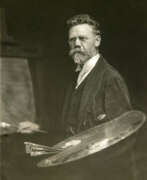

Robert Koehler was a German-born painter and art teacher who spent most of his career in the United States. Koehler was born in Hamburg; his family moved to Milwaukee, Wisconsin in 1854. There he attended the historic German-English Academy. He apprenticed himself to a lithography firm. In 1871, he went to New York City and stayed to work as a lithographer. After studying drawing in the night classes of the National Academy of Design, Koehler went to Munich to study fine art at the Royal Academy in 1873. In 1879, he was able to return to Munich. Koehler's work while in Munich won him silver and bronze awards from the Academy, and Bavaria's Cross of the Order of St. Michael. Koehler then set himself up as head of a private art school. He began to exhibit in the National Academy, New York, in 1877. In 1885 he took charge of a private school of art in that city. He organized the American department of the international art exhibition at Munich in 1883, and was appointed by the Bavarian authorities to act in the same capacity in the exhibition of 1888. In 1892 Robert Koehler returned to New York City to work as a portrait artist. The following year he moved to Minneapolis, Minnesota, accepting an offer to be the director of the Minneapolis School of Fine Arts (now the Minneapolis College of Art and Design). Koehler was also involved with the establishment of Minneapolis' Museum of Fine Art, now the Minneapolis Institute of Arts. He was a pioneer of art instruction and appreciation in the region. Koehler continued working in Minneapolis, painting portraits and landscapes, teaching painting, and arranging exhibitions. He retired as director in 1914.


Hermann Kohlmann is a Swiss and German painter, sculptor and graphic artist. He painted landscapes, portraits and figures. Kohlmann studied at the Dresden Academy with Richard Müller and Max Feldbauer. In 1934 he received the Hugo Goepfert Prize. In 1937 he became known to the general public through an exhibition at the Dresden Art Salon Emil Richter. He also exhibited at the Great German Art Exhibitions in 1937 and 1938. After serving in the army and being in captivity, he again worked in Dresden. Many of his works show the reconstruction of the city. Kohlmann was a member of the Association of Visual Artists of the GDR. From 1970 to 1980 he worked as a restorer at the Museum of the History of the City of Dresden.


Wilhelm Krauskopf is a German etcher and teacher. He studied painting in Dessau, Dresden and from May 1870 at the Royal Academy of Arts in Munich. During his studies, he took part in the Franco-Prussian war. From 1874 to 1877 he worked at the Imperial German Institute in Rome. From 1892 he taught at the Academy of Fine Arts in Karlsruhe, from 1894 he became a professor of etching and engraving. In 1896 he received a small gold medal at the International Art Exhibition in Berlin. Wilhelm Krauskopf created numerous portraits, as well as landscapes in the form of etchings from his own drawings, as well as from the work of other artists.






































